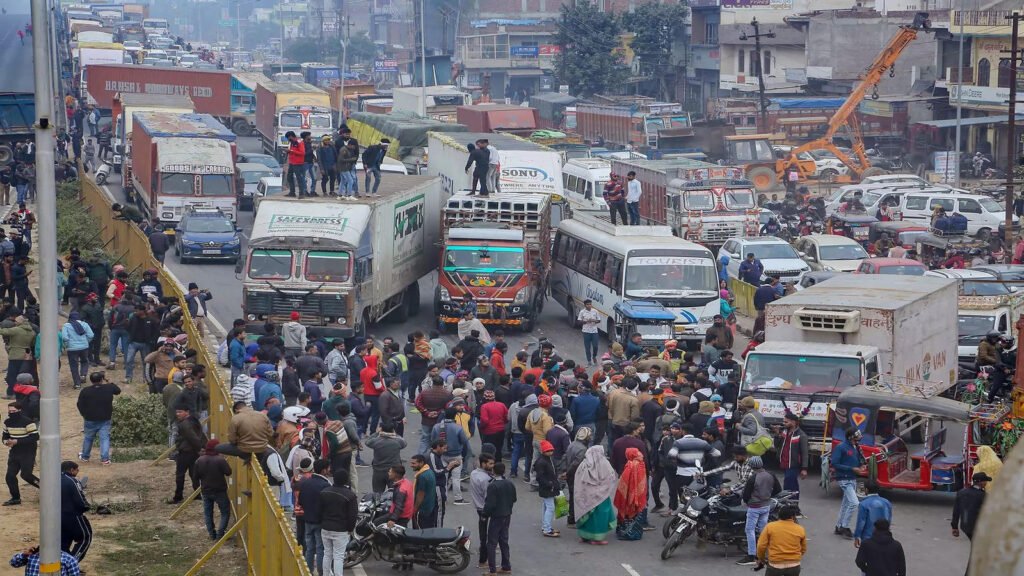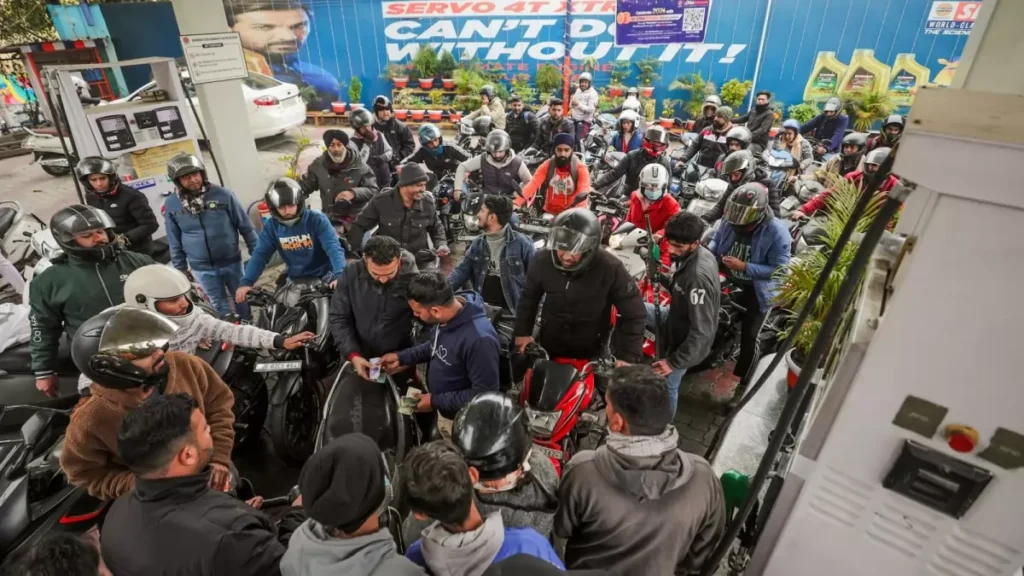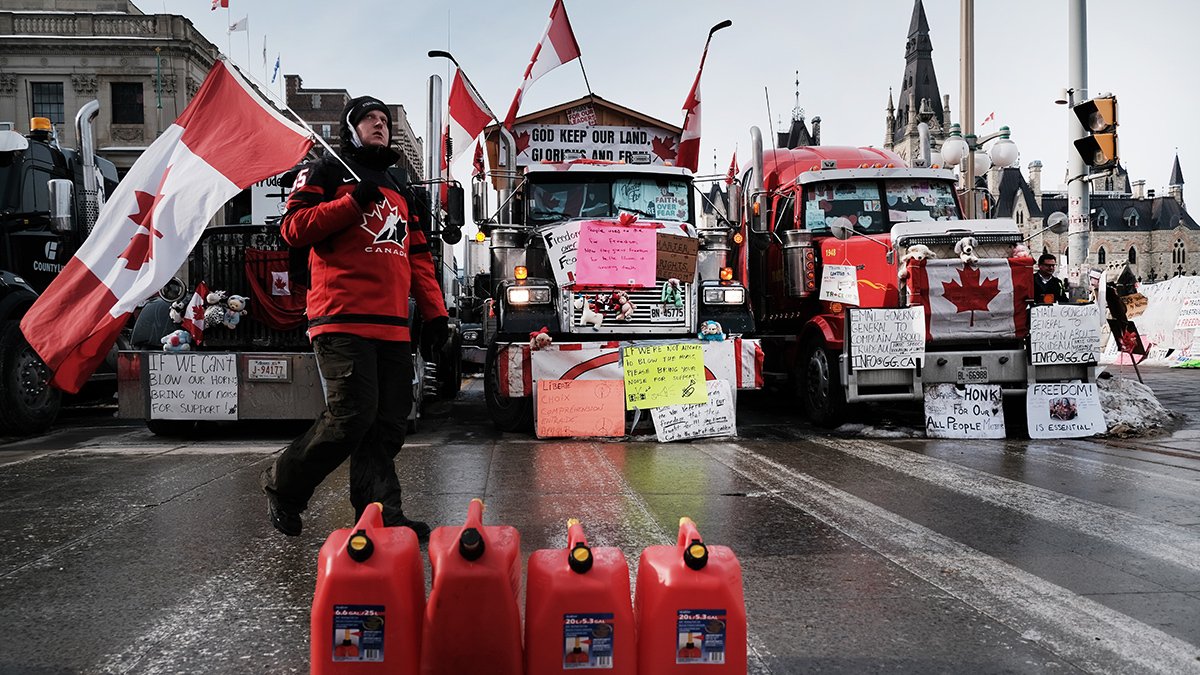Introduction:
Over the past few days, fuel pumps across various states in India have witnessed unusually long queues, not because of rising fuel prices but due to panic buying. The reason behind this frenzy is the ongoing protest by truck drivers protest in several states, including Bihar, Punjab, Maharashtra, Madhya Pradesh, Himachal Pradesh, and Chhattisgarh. This protest stems from their opposition to the soon-to-be-implemented criminal code. Bharatiya Nyaya Sanhita. Which carries high penalties for hit-and-run accidents.
Why Are Truck Drivers Protesting?
The heart of the matter lies in the high penalties stipulated for hit-and-run accidents under the new Bharatiya Nyaya Sanhita. Which is set to replace the colonial-era Indian Penal Code. According to the new law, individuals involved in hit-and-run cases could face up to 10 years in jail and a hefty fine of ₹7 lakh. This has sparked widespread concern and opposition, especially among truckers, cab drivers, and others operating commercial vehicles who question their ability to pay such substantial fines in the event of an accident.

The Protest’s Impact on Supply Lines:
Protests have not only hit the streets but have also affected crucial supply lines. Drivers of thousands of fuel tankers, responsible for transporting fuel to pumps, have joined the strike. As a result, a fuel crisis has already gripped several cities, and there are fears that other essential supplies might face a similar fate if the protest continues.
In Aurangabad. An association of petrol pump dealers has warned that fuel pumps in the district may go dry soon. Aqeel Abbas. The secretary of the association, mentioned, “Drivers of tankers that carry fuel have called for agitation and have stopped filling fuel.” Similarly, in Himachal. The strike has impacted the tourism sector. With reports of tourists struggling to find transportation as cab operators joined the truck drivers protest against the new law.
Protests Across States:
The protest has manifested itself in various forms across states. In Patna, truck operators raised slogans against the new law. Burning tires and blocking roads. The question echoed in the protests: who will feed their families if they are imprisoned for 10 years? In Navi Mumbai, a group of truckers attacked a policeman. Leading to the use of force to disperse the crowd on the Mumbai-Bengaluru highway.
Instances of protests and roadblocks have been reported from Thane. Bhopal. Raipur. Indore. Surat. Ambala. and various other cities. The sentiments expressed by the protesters reflect a deep concern about the potential implications of the new law on their livelihoods.
Voices from the Protests:
Gyansingh Yadav. A cab driver from Bhopal. Broke down while explaining the reasons for the protests. “People like me who drive cabs for a living still go home at night. But truck drivers protest often don’t meet their loved ones for 15 days or more. We are not against any government or law. But I feel some amendments should be made. Especially with regard to the penal provisions against drivers. The new law attracts a 10-year prison term for errant drivers. I feel it should be reduced to 1-2 years,” he shared.
In Raipur. A bus driver expressed, “We are poor people. Penal action should be taken against the owners of our vehicles. This law is unfair on us. We will continue to be on strike until our demands are met.” These voices highlight the human side of the protest. Emphasizing the challenges faced by those who make a living behind the wheel.
Understanding the New Law and Its Changes:
The focus of the protests is on the amendments introduced by the Bharatiya Nyaya Sanhita concerning hit-and-run accidents and death due to rash driving. The new law, which has received the President’s assent after clearing Parliament. Introduces two clauses under Section 104.
The first clause states. “Whoever causes the death of any person by doing any rash or negligent act not amounting to culpable homicide shall be punished. With imprisonment of either description for a term which may extend to seven years. And shall also be liable to a fine.” The second clause adds, “Whoever causes the death of any person by doing any rash or negligent act not amounting to culpable homicide and escapes from the scene of the incident or fails to report the incident to a Police officer or Magistrate soon after the incident shall be punished with imprisonment of either description of a term which may extend to ten years. And shall also be liable to a fine.”
Comparatively. The existing law. Under IPC’s Section 304A. Stipulates a punishment of imprisonment for a term not exceeding two years or a fine or both for causing death by rash or negligent driving.

Impact on Daily Life and Economy:
The strike has led to significant disruptions. With over 70% of an estimated 1.20 lakh trucks. Tempos. And containers in the Mumbai Metropolitan Region (MMR) remaining off the roads. The three-day strike is likely to impact the distribution of fuel and essential supplies. Potentially affecting the daily lives of citizens. In MMR alone, losses accruing from one day’s strike are pegged at ₹120-150 crore, according to the All India Motor Transport Congress.
Outside MMR. The impact is also felt in states like Maharashtra. Madhya Pradesh, Gujarat, Haryana, Punjab, Uttar Pradesh, Himachal Pradesh, Rajasthan. And Bihar. Cities such as Indore, Surat. And Ambala have witnessed drivers’ protests. Further contributing to the disruption of public transport and essential services.
The Way Forward:
The All India Motor Transport Congress has initiated a nationwide strike to voice its opposition to the stringent penalties for hit-and-run cases proposed by the new law. The truckers argue that these provisions. Which are yet to come into force. Could lead to undue harassment and must be reconsidered.
Mukesh Dave, president of the Akhil Gujarat Truck Transport Association, expressed confidence in finding an amicable solution. “We are in talks with the Centre to resolve the matter. And we are also engaging with drivers to encourage them to return to work. It is important to note that the law will not be implemented immediately. I am confident that an amicable solution will be worked out,” he said.
Conclusion:
As the truck drivers protest continues to make headlines. It brings to the forefront the challenges faced by those who form the backbone of India’s logistics and transportation system. The ongoing dialogue between the concerned authorities and the protesting truckers is crucial in finding a balanced solution that addresses the concerns of both parties. In the midst of this turmoil. The hope is for a resolution that ensures the smooth flow of essential supplies. Maintains public services. And acknowledges the legitimate concerns of those on the front lines of India’s transportation network.
